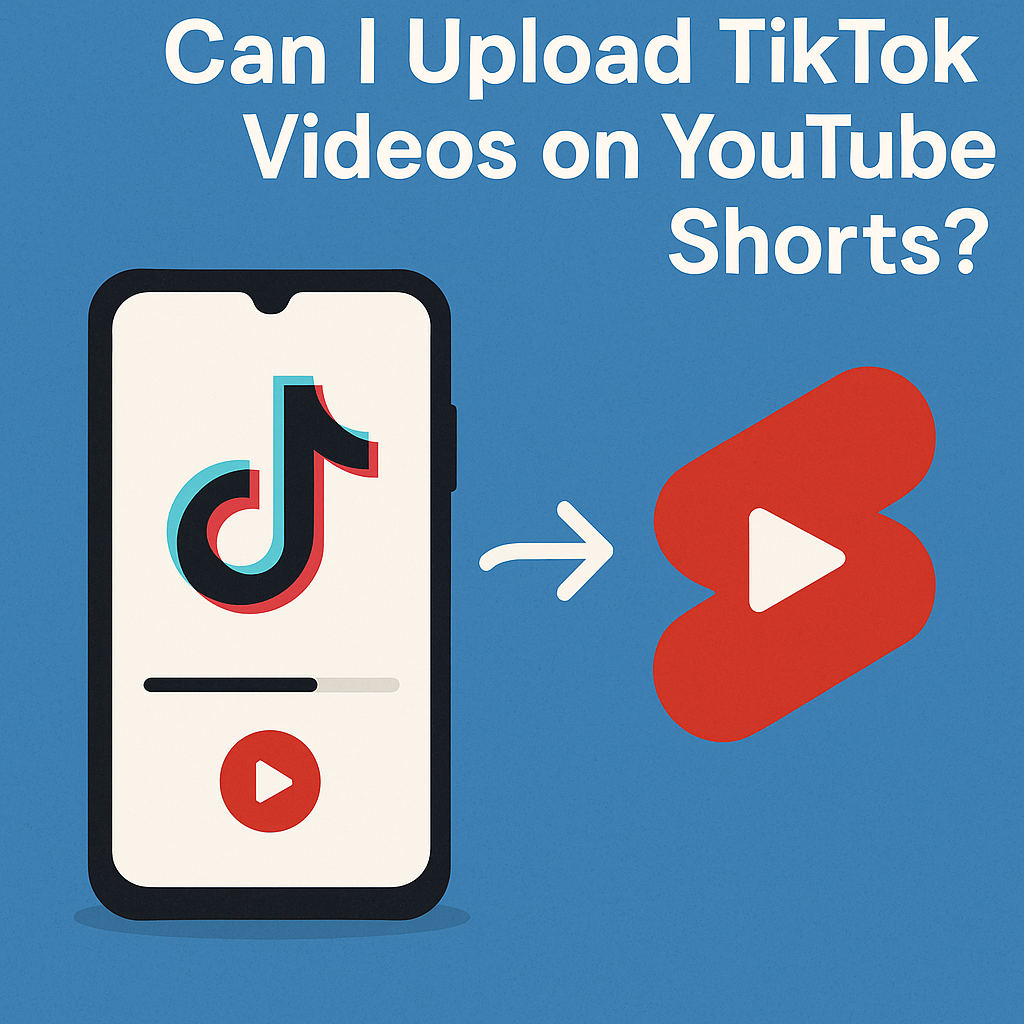Content repurposing raises important questions for creators wondering can i use tiktok videos on youtube shorts while respecting platform guidelines and copyright considerations. Using a tiktok to youtube shorts converter streamlines the process of adapting content between platforms, though creators must ensure they own all rights to the original content. Implementing bulk upload youtube shorts strategies saves time for creators managing multiple platforms, allowing efficient content distribution while maintaining quality standards across all channels.
Expanding your audience as a creator often means meeting viewers where they are. With short-form video platforms dominating social media, many wonder how to efficiently repurpose their work. This guide breaks down practical strategies for adapting your existing clips to new audiences.
Cross-platform sharing isn’t just possible—it’s a smart way to maximize your creative efforts. While each service has unique requirements, simple adjustments let you maintain quality and engagement. We’ll show you how to adapt vertical clips for different audiences without starting from scratch.
Automation tools can simplify the process once you understand both platforms’ specifications. From aspect ratios to hashtag strategies, small tweaks make your work feel native to each space. You’ll learn to create workflows that save time while boosting discoverability.
Building a multi-platform presence helps creators weather algorithm changes and reach diverse demographics. This approach lets you test what resonates while reinforcing your personal brand. Our methods focus on maintaining your signature style while meeting technical guidelines.
Key Takeaways
- Vertical clips can be adapted for multiple platforms with minor adjustments
- Automated tools streamline cross-publishing workflows
- Each platform’s audience benefits from tailored optimization
- Consistent branding strengthens recognition across services
- Quality preservation techniques prevent resolution loss
- Analytics tracking helps refine multi-platform strategies
Introduction to Cross-Platform Video Sharing
Short-form clips dominate social media, pushing creators to think beyond single platforms. With 2.6 billion monthly users, YouTube offers unmatched reach through its recommendation system. Pair this with TikTok’s rapid discovery features, and you unlock new growth opportunities.
Understanding the Rise of Bite-Sized Media
People crave quick entertainment that fits busy lifestyles. Vertical clips under 60 seconds now drive 73% of social media interactions. This shift demands adaptable content strategies.
| Platform | User Base | Content Style | Algorithm Strength |
|---|---|---|---|
| TikTok | 1.5B monthly | Trend-driven | Viral discovery |
| YouTube Shorts | 2.6B monthly | Search-optimized | Interest matching |
Strategic Advantages of Multi-Platform Presence
Sharing clips across services helps creators:
- Reach age groups that prefer different apps
- Balance algorithmic changes on single platforms
- Convert casual viewers into loyal followers
YouTube’s search-friendly format gives evergreen value to trending clips. TikTok’s “For You” page sparks initial interest, while YouTube sustains engagement through related video suggestions.
Benefits of Uploading TikTok Videos to YouTube Shorts
Maximizing your content’s potential means letting it work across multiple stages. Repurposing vertical clips for different services amplifies visibility while maintaining your creative vision. Smart creators know this approach turns one production session into lasting value.
Expanding Your Audience Reach
Each platform attracts unique demographics. YouTube Shorts users often seek tutorials or evergreen content, while TikTok audiences chase viral trends. Sharing clips on both services lets you capture diverse viewer groups simultaneously.
Platform algorithms boost discovery differently. TikTok prioritizes trending sounds, while YouTube considers search intent and watch history. This dual exposure helps build communities that might never overlap otherwise.
Leveraging YouTube’s Superior Search Algorithm
YouTube’s recommendation system acts like a 24/7 content promoter. It analyzes titles, descriptions, and visual elements to connect clips with interested viewers. Unlike fleeting trends, this search-focused approach keeps your work relevant for months.
Consider these advantages:
- Evergreen discovery through keyword searches
- Automatic suggestions to users watching similar topics
- Higher conversion rates from casual viewers to channel subscribers
One creator reported gaining 12,000 subscribers in three months by cross-publishing. Their cooking tutorials performed well as TikTok trends, then drove recipe searches on YouTube for ongoing growth.
can i upload tiktok videos on youtube shorts
Modern creators need streamlined solutions for managing multiple channels. Automated tools now handle technical conversions while preserving content quality. This approach maintains brand consistency across services without manual effort.
Explaining the Automatic Workflow Process
Third-party services bridge TikTok and YouTube through simple account connections. After linking profiles, users establish rules for content conversion. The system handles formatting adjustments and metadata transfers behind the scenes.
New clips appear on YouTube Shorts within 120 minutes of TikTok posting. This rapid turnaround keeps content fresh across platforms. The process eliminates repetitive downloading and re-uploading tasks.
Enjoying the No Watermark Advantage
Automatic branding removal gives clips a native YouTube appearance. Viewers see clean visuals without platform-specific logos. This subtle touch helps content feel purpose-made for each service.
One fitness creator reported 40% higher engagement after switching to automated posting. Their workout demos looked more professional without TikTok’s watermark. The time saved allowed for creating extra weekly content.
These tools also scrub hidden metadata like location tags. Your YouTube audience receives optimized versions tailored to that platform’s preferences. It’s like having a production assistant handling technical details automatically.
Step-by-Step Guide for Setting Up Integration
Streamlining content distribution between platforms takes less time than editing a single clip. With secure automation tools, you can bridge your social media profiles in three simple phases.
Connecting Your TikTok and YouTube Accounts
Begin by visiting your automation platform’s dashboard. Locate the Connections tab and select “+Add new connection”. Choose both platforms from the dropdown menu.
Log in using your standard credentials for each service. The system uses OAuth protocols, keeping your login details private. This secure method ensures no third-party access to sensitive information.
Creating and Activating the Automated Workflow
Navigate to the Workflows section after successful account linking. Click “+Create new workflow” to establish publishing rules. Set preferences for video formatting and scheduling.
Activate the automation using today’s date as the start point. The tool now monitors new TikTok posts, converting them for YouTube Shorts within two hours. One creator reported saving 9 weekly hours through this setup.
All steps can be completed from any internet-connected device. This integration lets your YouTube channel automatically populate with optimized content while you focus on creating.
Optimizing Your TikTok Content for YouTube
Strategic tweaks transform TikTok clips into YouTube hits. Platform-specific adjustments ensure your work feels native to each service while maintaining your creative vision. Let’s explore essential modifications that boost discoverability without sacrificing quality.
Adjusting Video Duration and Formatting
YouTube’s 60-second rule separates Shorts from regular uploads. Clips exceeding this limit appear as standard vertical videos, missing Shorts’ prominent placement. Automation tools solve this by trimming longer content to 59 seconds during transfers.
Maintain crisp visuals by checking aspect ratios before publishing. While both platforms use vertical format, YouTube displays slightly different margins. Test conversions to avoid cropped text or key visuals.
Converting content from tiktok to youtube shorts efficiently requires tools like a tiktok bulk video uploader to streamline the process when you upload tiktok to youtube shorts across platforms.
Understanding whether can i upload my youtube shorts to tiktok works both ways while managing tiktok daily video upload limit restrictions is crucial for content strategy.
Learning to bulk upload and schedule youtube shorts saves time when figuring out how to upload youtube shorts to tiktok for maximum reach. Deciding should i post my tiktoks on youtube shorts depends on your audience overlap and content strategy.
When uploading tiktoks to youtube shorts, be aware of youtube shorts tiktok watermark policy requirements that may affect visibility. Understanding youtube shorts vs tiktok platform differences helps optimize content for each platform’s unique algorithm and audience preferences.
Customizing Titles, Descriptions, and Hashtags
Craft punchy titles under 100 characters for maximum impact. Unlike TikTok’s descriptive captions, YouTube thrives on search-friendly phrases. Include keywords like “quick recipes” or “DIY hacks” to tap into 3.5 billion daily searches.
Hashtag strategies need platform awareness. YouTube uses 2-3 relevant tags for categorization, while TikTok demands trend-focused clusters. One creator doubled their views by swapping #ViralChallenge for precise terms like #HomeWorkouts.
Descriptions offer hidden optimization potential. Add timestamps for tutorials or product links for reviews. These extras keep viewers engaged longer, signaling quality to algorithms.
Managing Bulk Uploads and Backlogs
Building a content library requires smart distribution strategies. Platforms enforce upload limits to maintain system performance and content quality. Understanding these restrictions helps creators maintain consistent publishing schedules without overwhelming their audience.
Working Within Platform Boundaries
YouTube allows publishing up to 10 TikTok videos in one session. Exceeding this triggers a 12-hour cooldown. This system prevents spam while encouraging thoughtful content sharing.
For creators with extensive archives, manual daily publishing works best. Set reminders to share 10 clips every 24 hours. This method transforms large backlogs into steady content streams over weeks.
Highly active accounts benefit most from these guidelines. Those producing 5-10 daily videos can balance new creations with older material. Strategic scheduling prevents upload burnout while maximizing visibility.
Two approaches emerge after clearing backlogs:
- Switch to automatic cross-posting for future content
- Focus exclusively on new productions
Many find hybrid solutions effective. One beauty influencer schedules throwback posts every Friday while automating new tutorials. This maintains engagement without overwhelming subscribers.
Planning tools help visualize distribution timelines. Color-coded calendars track which videos get published when. This organization prevents duplicate shares and ensures fresh material always appears on schedule.
Optional Settings and Customizations
Tailoring your content strategy doesn’t require reinventing the wheel. Automation tools handle core functions effortlessly, letting creators focus on what matters—engaging stories. Custom options exist for those wanting extra polish without manual editing.
Implementing Video Templates and Branding
Consistent visuals boost recognition across platforms. Pre-made templates add intro clips, text overlays, or fade effects in seconds. One creator saw 30% higher retention after adding branded outros to cooking demos.
Adjust hashtag use based on platform culture. Strip TikTok tags for cleaner YouTube posts, or add search-friendly phrases. These tweaks help content feel native to each space while keeping your style intact.
Scheduling, Privacy Settings, and Advanced Tools
Batch-schedule posts during peak hours using smart calendars. Set default privacy levels or categorize content by topic—ideal for separating tutorials from vlogs. Receive email confirmations when clips go live.
Most find default settings sufficient, but power users enjoy granular control. Trim clips to 59 seconds automatically or resize for perfect framing. These behind-the-scenes tweaks maintain quality while saving hours weekly.

